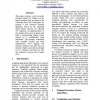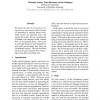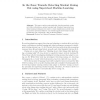1209 search results - page 6 / 242 » Using Prosodic Features in Language Models for Meetings |
NLPRS
2001
Springer
14 years 2 months ago
2001
Springer
This paper proposes a new prosodic phrasing model for Chinese text-tospeech systems. First, in contrast to the commonly used CART techniques, we propose a new inductive learning a...
COLING
2008
13 years 11 months ago
2008
We define the task of incremental or 0lag utterance segmentation, that is, the task of segmenting an ongoing speech recognition stream into utterance units, and present first resu...
ICASSP
2009
IEEE
14 years 4 months ago
2009
IEEE
The following article shows how a state-of-the-art speaker diarization system can be improved by combining traditional short-term features (MFCCs) with prosodic and other longterm...
ITS
2010
Springer
14 years 2 months ago
2010
Springer
This paper explores automatically detecting student zoning out while performing a spoken learning task. Standard supervised machine learning techniques were used to create classiï¬...
ICASSP
2009
IEEE
14 years 4 months ago
2009
IEEE
We investigate genre effects on the task of automatic sentence segmentation, focusing on two important domains – broadcast news (BN) and broadcast conversation (BC). We employ a...



